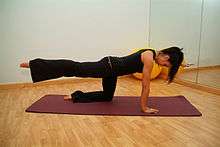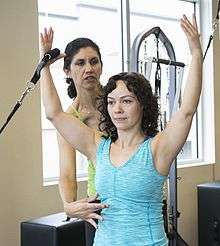Pilates

Pilates (/pɪˈlɑːteɪz/;[1] German: [piˈlaːtəs]) is a physical fitness system developed in the early 20th century by Joseph Pilates. It is practiced worldwide, and especially in western countries such as Canada, the United States and the United Kingdom. As of 2005, there were 11 million people practicing the discipline regularly and 14,000 instructors in the United States.[2]
Pilates called his method "Contrology" (from "control" and Greek -λογία, -logia).[3]
Pilates might help to condition the abdominal muscles of healthy people or alleviate lower back pain,[4][5] but there is no good medical evidence that it is of benefit to people with existing health conditions.[6]
Brief description
In his book Return to Life through Contrology,[3] Joseph Pilates presents his method as the art of controlled movements, which should look and feel like a workout (not a therapy) when properly manifested. If practiced with consistency, pilates improves flexibility, builds strength and develops control and endurance in the entire body.[7] It puts emphasis on alignment, breathing, developing a strong core, and improving coordination and balance. Pilates' system allows for different exercises to be modified in range of difficulty from beginner to advanced or to any other level, and also in terms of the instructor and practitioner's specific goals and/or limitations. Intensity can be increased over time as the body conditions and adapts to the exercises.[7]

History
Pilates was developed by Joseph Pilates, a physical-culturist from Mönchengladbach, Germany. His father was a prize-winning gymnast and his mother a naturopath. He studied both Eastern and Western forms of exercise including yoga.[8]
During the first half of the twentieth century, he developed a system of exercises which were intended to strengthen the human mind and body. Pilates believed that mental and physical health were interrelated.[9]
In his youth he had practiced many of the physical training regimes available in Germany, and it was from these he developed his own work. It has clear connections with the physical culture of the late nineteenth century, such as the use of special apparatuses and claims that the exercises could cure ill health. It is also related to the tradition of "corrective exercise" or "medical gymnastics" as typified by Pehr Henrik Ling. Joseph Pilates, like many Germans, was interned in Britain during World War I. On the Isle of Man, he started teaching other interned Germans about pilates.[10]
Joseph Pilates accompanied his method with a variety of equipment, for which he used the term "apparatus." Each apparatus was designed to help accelerate the process of stretching, strengthening, body alignment and increased core strength started by the mat work. The best-known and most popular apparatus today, the Reformer, was originally called the Universal Reformer, aptly named for "universally reforming the body." Eventually a full complement of equipment and accessories was designed by Pilates, including the Cadillac, Wunda Chair, High "Electric" Chair, Spine Corrector, Ladder Barrel and Pedi-Pole.[11]
Pilates published two books related to his training method: Your Health: A Corrective System of Exercising That Revolutionizes the Entire Field of Physical Education in 1934, and Return to Life Through Contrology in 1945.
His first students went on to teach his methods and open studios, and the most prominent include: Romana Kryzanowska, Kathy Grant, Jay Grimes, Ron Fletcher, Maja Wollman, Mary Bowen, Carola Treir, Bob Seed, Eve Gentry, Bruce King, Lolita San Miguel,[12] and Mary Pilates, Joseph's niece. Contemporary pilates includes both the "Modern" pilates and the "Classical/Traditional" pilates. Modern pilates is partly derived from the teaching of some first generation students, while Classical aims to preserve the original work as Joseph Pilates taught it.
Principles
Philip Friedman and Gail Eisen, two students of Romana Kryzanowska, published the first modern book on Pilates, The Pilates Method of Physical and Mental Conditioning, in 1980 and in it they outlined six "principles of Pilates".[13] These have been widely adopted—and adapted—by the wider community. The original six principles were concentration, control, center, flow, precision, and breathing.
Concentration
Pilates demands intense focus: "You have to concentrate on what you're doing all the time. And you must concentrate on your entire body for smooth movements."[14] This is not easy, but in pilates the way that exercises are done is more important than the exercises themselves.[14]
Control
"Contrology" was Joseph Pilates' preferred name for his method, and it was based on the idea of muscle control. "Nothing about the Pilates Method is haphazard. The reason you need to concentrate so thoroughly is so you can be in control of every aspect of every moment."[15] All exercises are done with control, the muscles working to lift against gravity and the resistance of the springs and thereby control the movement of the body and the apparatus. "The Pilates Method teaches you to be in control of your body and not at its mercy."[16]
Centering
For practitioners to control their bodies, they must have a starting place: the center. The center is the focal point of the pilates method.[17] Many pilates teachers refer to the group of muscles in the center of the body - encompassing the abdomen, lower and upper back, hips, buttocks, and inner thighs — as the "powerhouse". All movement in pilates should begin from the powerhouse and flow outward to the limbs. This is the main focus of pilates. It does this to strengthen the rest of the body. This can have effects for years to come if you are consistent with the exercise.
Flow or efficiency of movement
Pilates aims for elegant economy of movement, creating flow through the use of appropriate transitions. Once precision has been achieved, the exercises are intended to flow within and into each other in order to build strength and stamina. In other words, the pilates technique asserts that physical energy exerted from the center should coordinate movements of the extremities: pilates is flowing movement outward from a strong core.[18]
Precision
Precision is essential to correct pilates: "concentrate on the correct movements each time you exercise, lest you do them improperly and thus lose all the vital benefits of their value".[19] The focus is on doing one precise and perfect movement, rather than many halfhearted ones. Here pilates reflects common physical culture wisdom: "You will gain more strength from a few energetic, concentrated efforts than from a thousand listless, sluggish movements".[20] The goal is for this precision to eventually become second nature and carry over into everyday life as grace and economy of movement.[21]
Breathing
Breathing is important in the pilates method. In Return to Life, Pilates devotes a section of his introduction specifically to breathing "bodily house-cleaning with blood circulation".[22] He saw considerable value in increasing the intake of oxygen and the circulation of this oxygenated blood to every part of the body. This he saw as cleansing and invigorating. Proper full inhalation and complete exhalation were key to this. "Pilates saw forced exhalation as the key to full inhalation."[23] He advised people to squeeze out the lungs as they would wring a wet towel dry.[24] In pilates exercises, the practitioner breathes out with the effort and in on the return.[25] In order to keep the lower abdominals close to the spine; the breathing needs to be directed laterally, into the lower rib cage. Pilates breathing is described as a posterior lateral breathing, meaning that the practitioner is instructed to breathe deep into the back and sides of his or her rib cage. When practitioners exhale, they are instructed to note the engagement of their deep abdominal and pelvic floor muscles and maintain this engagement as they inhale. Pilates attempts to properly coordinate this breathing practice with movement, including breathing instructions with every exercise. "Above all, learn to breathe correctly."[26]
Effectiveness
In 2015 the Australian Government's Department of Health published a review of alternative therapies that sought to determine if any were suitable for being covered by health insurance; pilates was one of 17 therapies evaluated which was not found to be effective: there was no clear medical evidence that it helped improve outcomes for people with existing health conditions.[6]
Little reliable research is available on the safety and efficacy of pilates. For the treatment of lower back pain, there is limited evidence that pilates may provide greater benefits than other types of exercise,[4] and there is some evidence it can help with the conditioning of the abdominal muscles of healthy people.[5]
Legal status
Pilates is an unregulated method of exercise.[27]
On October 2000 "pilates" was ruled a generic term by a U.S. federal court, making it free for unrestricted use[28]
As a result of the court ruling, The Pilates Method Alliance was formed as a professional association for the Pilates community. Its purpose was to provide an international organization to connect teachers, teacher trainers, studios, and facilities dedicated to preserving and enhancing the legacy of Joseph H. Pilates and his exercise method by establishing standards, encouraging unity, and promoting professionalism.[29]
References
- ↑ "Pilates – pronunciation of Pilates by Macmillan Dictionary". Retrieved 8 July 2012.
- ↑ Ellin, A. (21 June 2005). "Now Let Us All Contemplate Our Own Financial Navels". New York Times. Retrieved 2007-09-20.
- 1 2 Pilates, Joseph (1998) [1945]. Pilates' Return to Life <3 through Contrology. Incline Village: Presentation Dynamics. ISBN 0-9614937-9-8.
- 1 2 Yamato TP, Maher CG, Saragiotto BT, Hancock MJ, Ostelo RW, Cabral CM, Menezes Costa LC, Costa LO (2015). "Pilates for low back pain". Cochrane Database of Systematic Reviews 7: CD010265. doi:10.1002/14651858.CD010265.pub2.
- 1 2 Campos RR, Dias JM, Pereira LM, Obara K, Barreto MS, Siva MF, Mazuquin BF, Christofaro DG, Fernandes RA, Iversen MD, Cardoso JR (2015). "The effect of the Pilates method on the physical conditioning of healthy subjects: a systematic review with meta-analysis". J Sports Med Phys Fitness (Systematic review). PMID 26004043.
- 1 2 Baggoley C (2015). "Review of the Australian Government Rebate on Natural Therapies for Private Health Insurance" (PDF). Australian Government – Department of Health. Lay summary – Gavura, S. Australian review finds no benefit to 17 natural therapies. Science-Based Medicine. (19 November 2015).
- 1 2 Mayo Clinic Staff (2012). "Pilates for Beginners: Explore the Core of Pilates". Mayo Clinic. Retrieved 2012-11-04.
- ↑ Pilates history.
- ↑ Studioequilibrium.com.br
- ↑ Eva Rincke: Joseph Pilates: Der Mann, dessen Name Programm wurde. Verlag Herder, 2015, ISBN 978-3-451-31295-3.
- ↑ "Pilates". isofitt.com.
- ↑ "Lolita Pilates - Lolita San Miguel — Internationally Acclaimed First Generation Pilates Master Teacher". lolitapilates.com.
- ↑ "The Pilates method book". Retrieved 2 February 2011.
- 1 2 Friedman and Eisen 2005, p. 13.
- ↑ Friedman and Eisen 2005, p. 14.
- ↑ Suzanne Farrell, cited in Freidman and Eisman 2005, p. 15
- ↑ Friedman and Eisen 2005, p. 15.
- ↑ Romana Kryzanowska cited in Freidman and Eisen 2005, p. 16
- ↑ Return to Life through Contrology, "Bodily house-cleaning through circulation" p. 14
- ↑ Barnarr MacFadden, Muscular Power and Beauty, chap VI, p. 47
- ↑ Return to Life through Contrology, "Bodily house-cleaning through circulation" p 14
- ↑ Return to Life, p. 12ff
- ↑ Freidman and Eisen 2005, p. 16
- ↑ Return to Life through Contrology, "Bodily house-cleaning through circulation", p. 13
- ↑ Romana Kryzanowska cited in Friedman and Eisen 2005, p. 17.
- ↑ Return to Life through Contrology, "Bodily house-cleaning through circulation"
- ↑ "PMA Quick Facts - Pilates Method Alliance". Retrieved 2015-07-30.
- ↑ U.S. District Court – Southern District of NY, Opinion 96 civ. 43 (MGC) October 2000, pilates.com
- ↑ "About the PMA - Pilates Method Alliance". www.pilatesmethodalliance.org. Retrieved 2015-11-28.
| Wikimedia Commons has media related to Pilates. |
Further reading
- Mazzarino M, Kerr D, Wajswelner H, Morris ME (2015). "Pilates Method for Women's Health: Systematic Review of Randomized Controlled Trials". Arch Phys Med Rehabil 96 (12): 2231–42. doi:10.1016/j.apmr.2015.04.005. PMID 25912668.